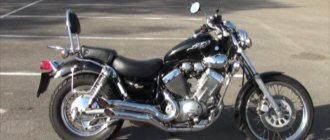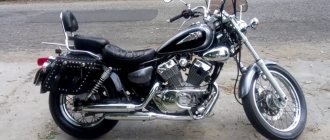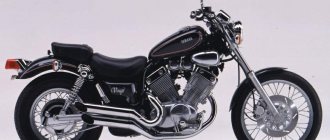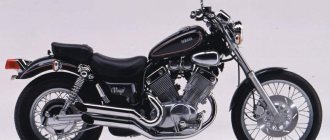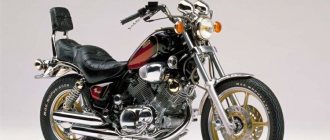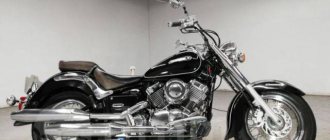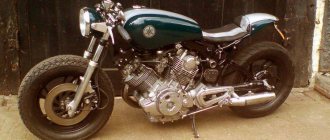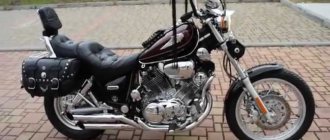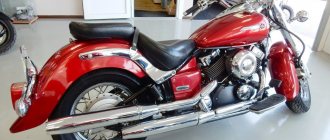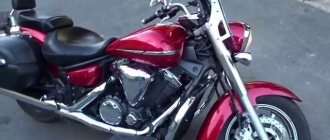- motorcycle model, Yamaha brand,
The Yamaha XV 250 Virago cruiser model appeared on the market in 1988 for the European and North American markets. The first versions (1988-1990) of the motorcycle in North America were called Yamaha XV250 Route 66. Since 1991, the model has become available in the domestic Japanese market, and in 2000 in the same market it was replaced by a new model - the Yamaha XVS250 Drag Star. In 2008, all export modifications of the Virago 250 began to be called the Yamaha V-Star 250, continuing to be produced until the present day.
The Yamaha XV250 Virago was based on a 2-cylinder V-twin air-cooled engine with a volume of about 250 cm³, producing 23 hp. power and 21 Nm of torque. The engine features a simple configuration with a single camshaft in each cylinder head and 2 valves per cylinder. Throughout its history, this engine had a carburetor power system (one carburetor). The same engine was installed on the Yamaha SRV250 model.
Other features of the Yamaha XV250 Virago include a steel tubular frame, simple suspension in the form of a conventional telescopic fork and a double shock absorber at the rear, front disc and rear drum brakes, chain drive, 5-speed gearbox, 9.5 liter fuel tank and 147 kg curb weight. masses.
The Yamaha V-Star 250 is currently in production and available in the North American and Australian markets.
Appearance
The Yamaha XV 250 Virago looks stylish thanks to the chrome elements and the glossy shine of the black frame. The motorcycle does not have any elements that are particularly noticeable. The front light is large, as ideally a cruiser should have. The wheels are spoked. Because the front wheel is slightly larger, the spoke pattern is slightly different between the front and rear wheels.
The black color of the frame and the bike as a whole visually lengthens the motorcycle, although it is long in itself. It cannot be said that it is high, and this is good, since choppers are distinguished by a high front part, and moderation in this moment is more typical for cruisers.
Modifications and competitors
The bike did not receive any modifications, but based on its engine, a model of the Yamaha SRV250 retro bike, available on the Japanese markets in the 90s, was assembled.
The Yamaha SRV250 was produced from 1992 to 1998 without any significant changes.
As a competitor to the bike, only Suzuki presents one model - GZ250 Marauder .
The rest of the Japanese put up a couple each.
- Kawasaki offered the EL250 Eliminator and VN250 Eliminator . Judging by the common name, the only difference is in the location of the pistons. The second one has a V-shape.
- Honda also offered 2 models. CMX250 Rebel / Honda Magna 250 .
It is interesting that the first one was mainly bought up by driving schools, and the second one became a real legend; it was not officially offered outside the domestic markets, but at the same time for a long time held the palm of the WORLD championship as the most frequently purchased small-capacity vehicle.
Comfort
This bike is convenient for those who wish to ride alone. It is possible to travel with a passenger, but it is not nearly as comfortable as many other cruisers due to the relatively small rear seat. The mirrors are large and will most likely be located directly opposite the driver’s eyes. In case of discrepancy, it is possible to adjust them slightly.
The ground clearance is low, and therefore the motorcycle can cope with not very bad roads. However, such a car is no longer suitable for off-road or even country roads. And this is not a problem of the model, but a feature of the entire class. It's a feature, not a minus. Due to its large dimensions, length and low ground clearance, such a machine is, in principle, not suitable for rough terrain.
Features XV 250
Since the VIRAGO 250 is still in production today, the model can be considered a unique representative of the retro class, which can still be purchased in completely new condition.
The bike has a lot of its own features, but not all of them can be called advantages:
- 2 springs on the rear suspension;
- low fuel consumption;
- light weight (noted by female riders);
- reliability and ease of maintenance;
- difficulty in finding original components (but considering that the entire line has long been cloned by China, this should not be a particular problem)
And:
- A gearbox that needs to be completed for comfortable movement. The bike comes from the factory in such a way that it is almost impossible to pry the shift paw with the toe of a shoe. It can be treated by removing the pedal from the splines and turning it a little higher. It is recommended to check several times. If the setting is very high, it gets touched when you put your feet on the pegs.
- The gas handle has a huge play. You can tighten the plug from below, but then jamming begins. What is better is up to the owner to decide. In both cases you need to get used to it.
Left handle.
Right handle.
- The steering wheel has strange locks in the extreme and middle positions, which does not have the best effect on maneuverability.
The need to maintain the chain can simply not be mentioned.
Dimensions and weight
In terms of dimensions, this is an average bike for the class. Compared to some cruisers, it even seems small. Although, if you compare the car with a sportbike or cross-country motorcycle, looking at a photo or video, the cruiser, of course, will look larger. At least visually.
The dimensions of the Yamaha XV 250 Virago are as follows:
- height – 1140 mm;
- width – 815 mm;
- length – 2189 mm;
- wheelbase – 1490 mm;
- seat height – 685 mm;
- ground clearance - 144 mm;
- curb weight – 147 kg;
- Tank capacity – 9.5 l.
Although the curb weight is small, the motorcycle sometimes falls over in a city traffic jam, especially if there are two people riding. But with larger cruisers the problem is even more acute. The tank volume is sufficient for recreational purposes. Taking into account the modern development of civilization, there are usually enough gas stations.
Brief history of the model
1988 - start of production and sales. Model: Yamaha XV250 Route 66 / Virago (USA, Europe). Factory designation: XV250U; 3DN1.
1989 - no significant changes. Model: Yamaha XV250 Route 66 / Virago (USA, Europe). Factory designation: XV250W; 3LU1, 3LS1, 3LW1, 3DN2.
1990 - no significant changes. Model: Yamaha XV250 Route 66 / Virago (USA, Europe). Factory designation: XV250A; 3DN3.
1991 - Model temporarily unavailable in the US market. Start of sales on the domestic Japanese market. Model: Yamaha XV250 Virago (Japan, Europe). Factory designation: 3DM5, 3DM6, 3LS1.
1992 - no significant changes. Model: Yamaha XV250 Virago (Japan, Europe). Factory designation: 3DM7, 3DM8, 3LS2, 3LW2, 3LU2.
1994 - no significant changes. Model: Yamaha XV250 Virago (Japan, Europe). Factory designation: 3DM9, 3DMA, 3DMB, 3DMC, 3DN4, 3LS5, 3LS6, 3LU3, 3LW3.
1995 - The front brake disc was moved to the left side and received a 2-piston caliper (instead of a 1-piston). The model is again available in the US, but under the familiar name Virago. Model: Yamaha XV250 Virago (USA, Europe). Factory designation: XV250G; 3LW4, 3LW5, 3LS7, 3LS8, 3LS9, 3DN5, 3LU4, 3LU5.
1996 - no significant changes. Model: Yamaha XV250 Virago (USA, Europe, Japan). Factory designation: XV250H; 3LW6, 3SLB, 3LU6, 3LSC, 3DN6; 3DMF, 3DMD, 3DME.
1997 - no significant changes. Model: Yamaha XV250 Virago (USA, Europe, Brazil). Factory designation: XV250J; 3LW8, 3LSJ, 3LU8, 3LSH, 3DN7; 4XT1.
1998 - no significant changes. Model: Yamaha XV250 Virago (USA, Europe). Factory designation: XV250K; 3LW9, 3LU9, 3LSL.
1999 - no significant changes. Model: Yamaha XV250 Virago (USA, Europe). Factory designation: XV250L; 3LWA, 3LSM, 3LUA.
2000 - The Yamaha XV250 Virago is replaced by the Yamaha XVS250 Drag Star in Japan and some European markets. Model: Yamaha XV250 Virago (USA). Factory designation: XV250M.
2001 - no significant changes. Model: Yamaha XV250 Virago (USA). Factory designation: XV250N.
2002 - no significant changes. Model: Yamaha XV250 Virago (USA). Factory designation: XV250P.
2003 - no significant changes. Model: Yamaha XV250 Virago (USA, Europe). Factory designation: XV250R; 2UJD.
2004 - no significant changes. Model: Yamaha XV250 Virago (USA, Europe). Factory designation: XV250S; 2UJH.
2005 - no significant changes. Model: Yamaha XV250 Virago (USA, Europe). Factory designation: XV250T; 2UJK.
2006 - no significant changes. Model: Yamaha XV250 Virago (USA, Europe). Factory designation: XV250V; 2UJP.
2007 - no significant changes. Model: Yamaha XV250 Virago (USA, Europe). Factory designation: XV250W1; 2UJT.
2008 - the name Virago 250 changes to V-Star 250. Model: Yamaha XV250 V-Star (USA, Europe). Factory designation: XV250XR; 2UJW.
2009 - no significant changes. Model: Yamaha XV250 V-Star (USA, Europe). Factory designation: XV250YR; 46B2.
2010 - no significant changes. Model: Yamaha XV250 V-Star (USA, Europe). Factory designation: XV250ZB; 46B4.
2011 - no significant changes. Model: Yamaha XV250 V-Star (Europe). Factory designation: 46B6.
2012 - no significant changes. Model: Yamaha XV250 V-Star (USA, Europe). Factory designation: XV250BB; 46B8.
2013 is the last year of production for the European market. Model: Yamaha XV250 V-Star (USA, Europe). Factory designation: XV250D; 46BA.
2014 - no significant changes. Model: Yamaha XV250 V-Star (North America, Australia). Factory designation: XV250EW, XV250ER, 46BC.
2015 - no significant changes. Model: Yamaha XV250 V-Star (North America, Australia). Factory designation: XV250FL, XV250FB, 46BF.
2016 - no significant changes. Model: Yamaha XV250 V-Star (North America, Australia). Factory designation: XV250GW, XV250GR, 46BJ.
2017 - no significant changes. Model: Yamaha XV250 V-Star (North America, Australia). Factory designation: XV250HS, 46BM.
2018 - no significant changes. Model: Yamaha XV250 V-Star (North America, Australia). Factory designation: XV250JB, 46BR.
2019 - no significant changes. Model: Yamaha XV250 V-Star (North America, Australia). Factory designation: XV250K1.
2020 - no significant changes. Model: Yamaha XV250 V-Star (North America, Australia).
2021 - no significant changes. Model: Yamaha XV250 V-Star (North America, Australia).
Specifications
The car has good parameters overall. The main disadvantage of the Yamaha XV 250 Virago, like the 125th model, is the drum brake at the rear. Yes, the bike is not particularly fast, but this still does not justify such a decision. This choice is largely due to the fact that the motorcycle was produced relatively long ago, when the drum version was not yet considered something that should be avoided.
| Motor type | V-shaped, 2 cylinders, 4 strokes |
| Power | 21 hp |
| Torque | 21 Nm |
| Maximum speed | 137 km/h |
| Acceleration to 100 | 10 s |
| Fuel consumption per hundred | 3 l |
| Drive unit | chain |
| Transmission | five-speed |
| Frame | tubular steel |
| Rear suspension | pendulum, two shock absorbers, stroke 99 mm |
| Front suspension | telescopic fork, 33 mm, travel 139 mm |
| Rear brakes | drum, 130 mm |
| Front brakes | single disc, 282 mm, 2-piston caliper |
The ideal option would be one brake disc at the rear and two at the front. But given the fact that more than thirty years have passed since the production of the model began, this is excusable. However, it is important to remember this when driving and not to accelerate too much. Otherwise, there is a high risk that the rear brake will fail and you will not be able to stop in time.
Name confusion
Since the start of production, the model has changed its name several times, and in each sales market this happened at a different time, which caused some confusion.
It is interesting that the motorcycle has not undergone any fundamental changes over the many years of production. The only thing that has been changed is the relocation of the front brake disc to the left side of the wheel.
At the official start of production (1998-1989), the motorcycle was called Yamaha XV250 Route 66 .
A year later, the bike begins sales in Japan under the name Yamaha Virago XV 250 , and a year later in the same market it is replaced by the Drag Star model (Yamaha XVS250).
- In 2008, in all other markets the model changes its name again. Instead of the Virago name, V-Star . The model is no longer produced for Japan.
- In 2013, the model completely went to the US markets, and variations with both new and old names are on sale.
What do the owners say?
Judging by the reviews of those who have repeatedly bought such motorcycles secondhand, it is not worth it. If you have enough money, it is better to get a new model. There is less risk that certain spare parts will be needed soon. Yes, maintenance is still inexpensive, but as you know, many people are too poor to buy things cheap.
In one review, the author claims that the model copes well with high speeds. But this is an erroneous judgment. The drum brake itself indicates that the bike is not suitable for racing or high-speed racing on a race track. The situation becomes especially dangerous in the rain.
According to the description of those who drove road motorcycles for a long time and then decided to switch to this cruiser, the model seemed heavy and clumsy. But after comparing with other cruisers, it became clear that it was all a matter of unfamiliarity. Those who switched to the model from motocross bikes feel even more discomfort.
Those who tested the motorcycle after heavier representatives of the class, on the contrary, note maneuverability and lightness in general. So often the owner’s assessment is largely subjective, and, perhaps, he himself does not always notice it. One of the advantages is the cost. About 150 thousand Russian rubles - that’s how much a new bike costs.
In conclusion, the Yamaha XV 250 Virago is a great bike for those who want a low-end cruiser from a bygone era. Especially considering that the model is still being produced. So it's sort of a retro piece of class that can be purchased in brand new condition. This doesn't happen often in the world of the motorcycle industry.
Despite the fact that I registered at the bikepost quite a long time ago, I decided to write my first post here right now. And it will talk about personal experience in operating this motorcycle, impressions of it. To put it briefly, the impressions are extremely positive, I fell in love with him from the first meters of movement, from the first minutes in the saddle. More details below. To begin with, a slightly lengthy preamble. It is important to note in comparison with what, I speak so highly of the Yamaha Virago 250 motorcycle, since everything is known in comparison. Therefore, you will have to go very far.
Like most of those present on this site (probably), I started my experience with two-wheeled transport with a bicycle, an ordinary Soviet one. In childhood, a “bunny”, then a “schoolboy”, then a Chinese double-suspension Auchanbike. Since I am also very interested in various technical hardware, even then, I dreamed of not turning pedals, but moving with the help of some kind of motor, looking at the Soviet motorcycles that were still widespread on the roads at that time. For some ten years this dream went into a deeply latent form, until I met one of my friends on a very extravagant means of transportation. What appeared before my eyes was the frame of the “Ukraine” bicycle, equipped with a 20” rear wheel from the “Aist”, a standard front wheel, and a horned handlebar with handles curved backwards, like on road bicycles. In the middle of the frame was a vintage D-6 engine and a custom gas tank that fit perfectly inside the frame above the engine. Along the way, a lot of strange trinkets were hung on the frame, giving this vehicle an even more outlandish look. This vehicle simultaneously resembled a board tracker from the early 20s of the 20th century, a chopper due to the seemingly long frame and a small wheel at the back, and a rat-style motorcycle assembled from parts from the first trash heap, which turned out to be not far from the truth. To my question, what kind of vehicle is this, a friend gave an exhaustive answer: “This is a Pepyakotsikl, a vehicle that runs on liquefied Pepyak, makes “puff-puff” and at the same time pushes the UG to the glory of Onotola and Chuck.” Those who in 2008-2009 were “obsessed” with the Internet “dope” movement will generally understand what we’re talking about. My dream of my own motorized transport flared up with renewed vigor, and my own name was firmly attached to his concept of a bicycle with a motor.
Then it was decided to follow in the footsteps of a friend and repeat the device he created. After going through several iterations, during which it was assembled first on a frame from the “Orlyonok”, and then from the “Ukraine”, it changed several sets of wheels and the engine. As a result, it received a finished look, described in an article about the Odessa-Kiev run and back from Ascender, with wheels on strong double rims, a cheap suspension fork and a Chinese F50 engine, which is a copy of the Soviet “Deshka”, in which many of the shortcomings were eliminated designs.
I rode it around the city and nearby suburbs, imagining myself as a Harley rider on an American highway. I think it’s already clear that among the motorcycles I liked the “cruiser” and “chopper” styles the most. But then, as a first-year student, I could only dream about them.
At that time, there were still times when licenses and registration with the traffic police for mopeds were not needed in Ukraine. And a lot of scooters, “alphas” and the like were scurrying through the streets. And at some point mopeds appeared, stylized as choppers, with the same 50cc engine as on the Alpha. Then I didn’t yet know that these were Chinese clones of the Honda Jazz, everyone knew it under the name “minichopper”, and it was produced under the loud-sounding brands “Viper Harley”, “Regal Raptor”, “Iron Eagle”, etc. It was then that I thought that this was exactly what I needed - I didn’t need a license, I didn’t need registration, spare parts were cheap, and the moped itself wasn’t expensive either. True, there wasn’t a lot of money back then and for 5 long years (or even more) I couldn’t dare to purchase one. During this time, laws changed, licenses were introduced for mopeds, but in principle they continued to turn a blind eye to the lack of them among mopedists. One way or another, the Viper Harley moped was purchased, and the Pepyakocycle was sold to the same friend, so that I knew that my first self-propelled horse was in good hands.
We can also talk about the moped for a long time, but in short it felt like a Mercedes after a Zaporozhets - the seating position is comfortably low, the suspension is soft, the traction is powerful (it turned out that the engine was equipped with a 72 cc CPG), the exhaust sound is soft and bassy. As a result, my love for cruisers only grew stronger, but I still continued to dream of a “real American-style motorcycle.” While logging kilometers on a moped, I began to become more closely acquainted with the world of motorcycles, read about them, and learned that a motorcycle with a lot of chrome, a hellishly roaring exhaust and a V-Twin engine is not only Harley-Davidson, but also many other manufacturers, primarily “ Japanese four”, intending to conquer the American market by copying the general HD style. Then the requirements for the future new motorcycle were formed: weight up to 150 kg, low cost, simplicity of design, calm disposition, and, of course, a chopper-like appearance. The V-Twin engine was very desirable. At the same time, I came across various light motorcycles made in China, really cheap (on average around $1000-1200 when new), visually similar to a chopper (slightly forward fork, plenty of chrome parts), but the engine was almost always a single-barrel with a displacement of 125 -200 cubic meters.
While looking through various materials, I also came across a humorous article about motorcycles and bikers on the website lurkmore.to, where there is a picture designed to help in choosing a motorcycle in accordance with the preferred style and price range.
It was there that I saw the Yamaha Virago 250 for the first time. The motorcycle struck me with its very laconic design, ideal proportions, and an engine that vaguely resembled the famous Panhead from HD due to the decorative covers on the cylinder heads. Yes! Here it is! Exactly what I want. There was actually an error in the picture - for some reason it was labeled as a Yamaha Virago 400, although the 400ka has a radically different appearance, I must say, quite unique. The 250ka looks more familiar. I started looking for detailed information about this model. As it turned out, the history of this motorcycle began back in 1988, when it was first released under the name Yamaha Route 66. Since 1991, the name was replaced with Virago, which roughly means “witch” in Russian. Since then, it has experienced only minimal changes in design and is still produced, but with the name Yamaha V-Star 250. The motorcycle is assembled on a steel duplex frame, it has an air-oil-cooled engine, 250 cc with a power of 23 hp . power and 21 Nm of torque, 5 gears, with one carburetor, electronic ignition and electric starter. The suspension consists of a simple telescopic fork at the front and two separate shock absorbers at the rear. The transmission is made of a chain, the braking system is represented by a single disc with a two-piston caliper on the front wheel and a simple drum brake on the rear. The weight of the motorcycle is exactly the same 150 kg.
The absence of water cooling is a huge plus - you don’t have to worry about coolant leaking or damaging the fragile radiator with a random stone. A single carburetor guarantees no headaches with tuning and synchronizing the usual Japanese V-twin systems with two carburetors. The absence of a cardan drive reduces the weight of the motorcycle. Although they say that the cardan is reliable and does not require frequent maintenance, and you can completely forget where that cardan and bridge are located, there is still a non-zero chance of winning the jackpot in the form of a sudden malfunction of this unit. Although a chain drive requires regular lubrication and tightening, in terms of cost and speed of restoration in the event of a breakdown, it cannot compete even close to a cardan drive. Studying information about the motorcycle, another undeniable argument emerged in favor of choosing it - it was also cloned by the Chinese under the name Lifan Virginia and a couple of other companies. This means that spare parts will be cheap and easily accessible.
Surprisingly, all over the Internet there was an extremely meager number of reviews from real owners of this vehicle and video reviews of it. The video reviews were very sparse and, for strange reasons, mostly outside the English segment of the Internet, mostly some kind of Spanish-language. I also found exactly three reviews in Russian, and all of them were collected only on the website. There were no full stories about the experience of owning it on this site either. Communicating with people and asking questions about the Virago 250, I only came across a wall of misunderstanding with answers like “why do you need it”, “only enduro is suitable for our roads”, “Honda is our everything” and “a cruiser should be at least a liter, everything else bullshit." One way or another, I still did it my way, without allowing myself to be convinced. All that remains is to decide on the choice - an old Japanese or a more recent Chinese. As stated on the Internet, internally Lifan and Yamaha are identical down to the last screw, spare parts between them are completely interchangeable. The goal was set, and all that remained was to save some money while monitoring advertisements. Prices for the Chinese versions started from $500 and had an average value of 800-1000, while the Japanese ones cost from 1000 to infinity (there were cases when the price of a mini-viraga completely overlapped with the price of a rolled shame-600 or a volcano-400). I immediately rejected the options for ordering from a Japanese auction, since, firstly, this business is poorly developed in Ukraine, and secondly, it is in many ways a pig in a poke - it is unknown what will be delivered and in what condition, and whether it will be brought at all. The price also turned out to be extremely unprofitable due to outrageous customs duties and delivery prices - the final price again exceeded the average for the old shame-400 available to a private individual. So I had to choose only from the copies available in my country from real owners.
As a result, one February day I came across an advertisement for the sale of the Japanese version of the Virago 250 right in my hometown for $1,100. Externally, “The Witch” looked very well preserved, despite its 1994 release. The gas tank and fenders are in a very beautiful dark green color, chrome to a solid “4”. The only thing that confused me was the clause in the ad “sale by registration certificate”, which means that the seller is not the legal owner of the motorcycle, but uses it by proxy from the previous one. A couple of days later the ad was removed from publication, but I still decided to call the seller. It turned out that he had withdrawn the motorcycle from sale because he was tormented by potential buyers who asked a lot of questions, but ultimately refused to purchase it. And then there was another surprise - the motorcycle was in a garage a couple of blocks from the house. 5 minutes after the call I was already standing next to him.
It turned out that the seller took good care of it - everything was rebuilt, repainted, many spare parts were changed. There was a fresh, already Chinese engine, exhaust, new front wheel, new pendulum. What caught my eye was the truck's pneumatic horn as a horn, the beautiful chrome steering wheel grips, and the tail light in the shape of an iron cross. In fact, only the frame with the fork, rear wheel and body kit remained original. We were also surprised by the overall size of the motorcycle - it was only slightly larger than a moped. Some defects left by the seller came to light - when replacing the front wheel, he did not adjust the speedometer drive to it, as a result, the mileage froze at about 40,000 km, how much he wound up afterwards is unknown to anyone. The front brake was remade very carelessly - there was a non-original two-piston caliper, for which the seller did not bother to make the correct adapter - as a result, the pads captured the disc only 20% of their area, reducing the entire effect of this caliper to zero. The third point was the dead battery. And the fourth - an inconspicuous crack in the rear backrest, which “does not affect the speed.” After talking about the history of the motorcycle, we moved on to trying to launch it. It was not possible to start it right away, having dropped the battery to zero and only “lighted” it from the car. Hearing the sound of the engine, I just burst into a crazy smile.
He asked for a week to “think about it” in order to find the legal owner. The seller reluctantly agreed, while firmly refusing to bargain. That’s what I “thought” for a long time, assuming that with a 90% probability it would become my very motorcycle. We managed to find the primary owner quite quickly, and he agreed to issue a new power of attorney for my friend without any problems. On the same day, I gave the seller a deposit, took the documents, and a couple of days later I paid in full and saddled my new horse. Right on the same day, at a temperature only slightly above zero, I immediately covered 20 km, leaving the city on the Kyiv highway and then back home, where I was able to photograph it in more detail.
The sound, dynamics, speed were simply amazing. Compared to a Chinese moped. It accelerated with ease by lightly unscrewing the handle with a pleasant rumble of the engine, and braked just as easily by lightly pressing the rear brake pedal, and a slightly stronger press led to the wheel locking. On a moped, I had to press the pedal as hard as I could to slow down to the point of locking up. It was as easy to control as a moped, despite its higher center of gravity. He overcame the climbs without slowing down and even without changing gears; he only had to unscrew the handle a little more. The suspension was also a pleasant surprise - the bumps did not hit you in the back through the butt, but smoothly flowed over the wheels, it felt like you were sitting on a boat at sea, crossing small oncoming waves. A few days after the first trip, I drove it into my garage, and then continued to move around on the moped.
In the spring we managed to re-register it as ours, not without incident. Why not without adventure? Because I had to spend the whole day at the traffic police, from 8 a.m. to 5 p.m., mostly in queues. And during the inspection, the inspector considered it necessary to dig into the non-native Chinese engine, although the engine number has not been included in the registration certificate for about 10 years, which means that it can be changed to the same one at your discretion. In the summer I managed to learn and pass my license categories A and B. Before that, I periodically drove a “witch” without a license.
At some point, I realized that the motorcycle sounded too quiet and gentle compared to “stereotypical choppers”; the sound began to displease me. Then I decided to change the stock exhaust to a direct flow one. There was a video on YouTube about what happens after installing a direct flow. The author of the video described the result as follows: “I wanted to sell my viraga and increase the cubic capacity, but then I was advised to change the exhaust. I don’t want to sell the virus anymore.” I will leave a link to the video below.
First, I looked on the Internet for ready-made Chinese direct-flow kits and was horrified at the price.
Then I decided that “we have a mustache ourselves” and bought some plumbing pipes and corners. After which I took up the grinder and welding. I didn't take detailed photos of the process, but some can be seen below.
I made my own direct-flow exhaust in its most radical manifestation - simply empty exhaust pipes are attached to the engine cylinders. Without any partitions, flutes, etc. The result exceeded all the wildest and timidest expectations - the sound became low gurgling at idle and terrifyingly loud when unscrewing the knob, reliably reaching the pain threshold of the ears. And when the gas is released, more sounds appear, ranging from the “sound of balls rolling from a bearing” in the pipes to the rich and loud pops of unburned gasoline. The “Witch” finally began to behave in an appropriate manner - sending out loud curses to everyone on the street within a kilometer radius. After a test drive, the pipes were removed, painted, wrapped with fiberglass tape for appearance, and reinstalled.
In principle, I decided to stop there with making changes to the motorcycle. Since the purchase, I have traveled 10,000 km in less than 2 year-round driving around the city and region. I don’t get tired of it in any way, contrary to the opinion that “you’ll get tired of a small-sized tank in 1 season.” Moreover, we don’t even have to open or close the season as such, but travel almost all year round. Last winter, snow fell only once, generously covering the motorcycle.
But this did not become an obstacle to traveling to work and back, especially since the roads were well cleaned. In general, it has never seriously let me down, especially considering the rather harsh operation, including transporting construction materials and other heavy loads in the back seat. Below I will describe the problems that I encountered during this time.
First of all, it was necessary to finalize the imperfections left by the seller - an adapter was made that would allow connecting the speedometer drive gear to the front wheel. I also made an adapter bracket for installing the front brake caliper so that it fully encircles the disc. The bracket was cut out of a piece of sheet steel 6 mm thick, and the holes were drilled in place. The caliper also had to be modified somewhat by milling off excess metal. The first serious problem that arose on the motorcycle was the front brake sticking in the clamped position. It could manifest itself in the following way: I put it in the garage in the evening, and the next morning the front wheel was tightly blocked. It was treated only by bleeding a small amount of fluid through the nipple for pumping on the caliper. Subsequently, after several dozen strokes of the handle, pressure gradually “accumulated” in the brake system until the pads stopped releasing the disc when the handle was released - the problem was clearly in the brake machine, in which the fluid was not bypassed properly. The problem was solved by replacing the brake machine. Replacing the brake fluid, bleeding the brakes, overhauling all components and similar standard procedures did not give any results. The next thing to die in the motorcycle was the battery, losing almost all of its capacity. I drove for about a month without a battery, starting the engine from a pushrod. It was a shame that there was no kickstarter for it. By the end of the first year of ownership, I replaced the oil and oil filter in the engine; until then I had not messed with it at all. About two glasses of waste drained from the crankcase instead of the required one and a half liters. And what’s most surprising is that this was still enough for all critical components to be lubricated; apparently the oil intake is located as low as possible. I use regular automotive oil 10W40 from Castrol. I don’t even mention lubrication and tightening of the chain - standard procedures, done as needed. A few months later the plug leaked. It was very difficult to find time, but in the end I replaced the oil seals and boots, filled in new oil, Motul for medium-viscosity forks.
Since then, there have been practically no problems, only at the end of this year, with the onset of autumn and damp weather, the spark weakened greatly, which led to extremely difficult starting. Cured by replacing both ignition coils. When replacing the coils, a cracked rubber intake manifold was also discovered - I also replaced it. I also machined new bushings from caprolon into the rear shock absorbers to replace the crushed silent blocks - the stability of the motorcycle immediately improved significantly. I am pleased with the relatively convenient layout of all components - to access all the electrics and the carburetor, you just need to remove the seat and gas tank, which takes literally 2 minutes. Just in case there was a serious malfunction in the motor, I bought a spare motor completely assembled, as a donor of spare parts, also Chinese, since I got it at a very good price of $300 at the disassembly of a Chinese virag (I had to take the whole motorcycle ). The motor is in working order.
Along the way, I bought a couple more spare cylinders and one head (sold en masse for $40). So far, not a single part from it has been needed, pah-pah-pah. With the exception of the mentioned malfunctions, which were eliminated within a maximum of a few hours, the motorcycle regularly brought enormous pleasure - I wanted to ride it all the time, and not only to get from point A to point B, but also simply for the sake of the process. Once I even managed to get out to Bonneville to “take pictures.”
And now we can sum up the results by briefly listing the pros and cons (who doesn’t have these, these cons).
So, the advantages:
• Cheap. Chinese versions sometimes come across really cheap - the minimum price I saw was $500 - 50cc scooters are sometimes more expensive. • A very reliable motor, which the Chinese did not manage to spoil with materials of random quality, this is clearly the merit of the Yamaha engineers who competently designed it. In the 10,000 kilometers of MY mileage alone, I have not climbed into it even once - there was no need. The engine pulls great, no extraneous sounds are heard (I don’t rule out that they are simply hidden behind the loud exhaust ). It is unknown how long the previous owner rode it. At the same time, the engine is also very flexible - you can safely drive with only 3 gears - switch in 1-3-5 mode or 1-2-5 if you want to turn it into the cutoff. I don't abuse the latter. • Minimum gasoline consumption. On the highway at an average speed of 70 km/h the consumption is only 2.5 liters per hundred, but in the city it is about 3.5-4 liters. The moped's consumption on the highway is similar, in the city it is slightly less. • Simple design with a minimum of parts, making it easy to do repairs yourself. Chinese spare parts, although more expensive than for Chinese mopeds, are still quite cheap, and are always available in stores in the city. The original Japanese ones, only made to order, are many times more expensive, and you also have to wait until they arrive. • Generally calm character. When accelerating, it does not try to jump out from under its ass; the maximum speed magically sticks to 130 km/h - the maximum permitted limit on highways according to traffic regulations and varies by 10 km/h back and forth depending on the terrain and wind direction. There’s no need for more – they ride cruisers and choppers to enjoy the surrounding views while listening to the sound of the engine. Comfortable cruising speed is 80-90 km/h, at 100-110 there is a blow in the face, and the engine is already bursting. • Excellent directional stability on straight, level roads, characteristic of all cruisers. And its miniature size and lean “physique” give it the opportunity to obediently steer in almost any road situations with a minimum of effort, and climb into almost any aisle. Mirrors interfere with crawling into impassable, very narrow aisles - they can cling to the mirrors of cars standing on the sides. • Insensitivity to falls. As you know, there are motorcyclists who have already fallen and those who will fall again. In my case, there were some falls, but the motorcycle is made in such a way that when falling on its side, it touches the ground with only 3 points - the rear wheel, the kickstand and the mirror. In the worst case, the turn signal, usually the front one, breaks. But the price is 4-5 bucks on market day. A set of Chinese mirrors costs the same.
Now about the disadvantages:
• Virago-250 is a small motorcycle. The base is relatively short, sometimes I feel cramped on it. There is nowhere to stretch my legs. Personally, I would like “the same coat, only with mother-of-pearl buttons,” or rather, a frame 20-30% longer. In addition, he is sometimes taken lightly by those around him with jokes like “how can you ride a motorcycle for girls?” This disadvantage is quite subjective. • Difficulty catching neutral gear. In 70% of cases, when switching from 1st or 2nd gear to neutral, it slips. If it weren’t for the light bulb, it would be real torture to catch it. Perhaps this is a problem specifically with my copy. Adjusting the clutch turned out to have nothing to do with it. • Lack of kick starter. It happens that the battery is dead, and there is no opportunity to buy a new one right now. For a month I tried to push it to get it started. • Sometimes the dynamics were just a little lacking in several specific driving situations. If you remember that this motorcycle is not designed for annealing on the drag track and sharp shots from around the corner, then this point is not a drawback. You just need to avoid situations where sudden acceleration may be necessary, and calculate your maneuvers in advance.
With this, I think I’ll finish my presentation of my current personal experience with the Virago 250. The little “witch” doesn’t get boring at all, but sometimes I ask myself whether I want something more, and if I want, what exactly. I want a chopper. I confess, I sometimes dreamily licked my lips at the Honda Fury, which became for me the ideal of a chopper appearance among mass-produced motorcycles. But, after reading the reviews and learning that there is a lot of plastic, dropsy, an injector, a cardan and all this for 10 thousand bucks, then immediately any desire to look in its direction disappears. What then remains? Go the only right way. Slowly build a chopper yourself, as you should do it. And it will be based on the engine from Viraga-250, since it already exists. In my subjective opinion, this is one of the most beautiful engines in terms of appearance. However, this is a completely different story, which will take place in the not very near future.
I hope my story was useful and will help someone in choosing their first motorcycle.
